Abstract
This paper presents the design and development of a technique for an Autonomous and Versatile mode Parking System (AVPS) that combines a various number of parking modes. The proposed approach is different from that of many developed parking systems. Previous research has focused on choosing only a parking lot starting from two parking modes (which are parallel and perpendicular). This research aims at developing a parking system that automatically chooses a parking lot starting from four parking modes. The automatic AVPS was proposed for the car-parking control problem, and could be potentially exploited for future vehicle generation. A specific mode can be easily computed using the proposed strategy. A variety of candidate modes could be generated using one developed real time VHDL (VHSIC Hardware Description Language) algorithm providing optimal solutions with performance measures. Based on simulation and experimental results, the AVPS is able to find and recognize in advance which parking mode to select. This combination describes full implementation on a mobile robot, such as a car, based on a specific FPGA (Field-Programmable Gate Array) card. To prove the effectiveness of the proposed innovation, an evaluation process comparing the proposed technique with existing techniques was conducted and outlined.
1. Introduction
Nowadays, automatic parking systems function as an important component for new vehicle generations. The need to introduce an Autonomous and Versatile mode Parking System (AVPS) for the parking of future vehicles was the main motivation of this paper. It is expected that all vehicle manufacturers will adopt a unique configuration for automatic or semi-automatic parking, which takes the driver some minutes to find a parking lot that suits an already pre-programmed configuration. Before starting the presentation of the proposed AVPS developed system, we have studied a number of automatic parking systems of vehicles in the literature that have been developed by researchers in the field of automatic parking systems.
Authors in [1] focused their research on the parallel motion planning using Poisson-disk sampling. The paper deals with a rapidly exploring-random-tree-based parallel motion planning algorithm that uses the maximal Poisson-disk sampling scheme. In paper [2], authors resolved the problem of generating a smooth parallel parking maneuver for autonomous car-like vehicles and formulated the problem in a point-to-ray framework connecting the parking position to all points in a neighborhood of the intermediate point. The proposed method was validated using a double-tracked Ackermann steering vehicle model.
Implementation of an Autonomous Driving System using a smart phone for parallel and perpendicular parking was proposed by Ming-Hung Li and Po-Kai Tseng [3]. The proposed system was carried out with theoretical algorithm and hardware integration; the result demonstrated the ability of vehicle parking. Authors in [4] also proposed an automated perpendicular parking system using approximated clothoid-based local path planning. The feasibility of the proposed technique was proven by the real-car test.
A general two-step trajectory-planning algorithm from the robotics literature has been applied to generate suitable trajectories for an autonomous parking maneuver of a car [5]. In this study, the size of the parking space was taken into account by an adaptive choice of the maximum allowed velocity during the parking maneuver. It was reported [6] that, a variety of candidate paths was generated using a conventional back-propagation scheme for the path planning algorithm for the car-parking control problem. Optimal solutions were obtained with respect to performance measures, such as collision safety, moving distance, control efforts and so on.
Many other works have been considered in studying parking behaviors and improving parking efficiency. Such research defines a specific model, which was built to understand the parking choice behavior, as presented in papers [7,8,9]. In most of these models, competing alternatives are already suggested prior to decisions. Otherwise, and firstly, a simple parking path programming strategy for an automatic parking system was provided [7]. This strategy employs the minimum turning radius of the vehicle by means of an infrared distance sensor to determine the parking path, simplifying its analysis without any need for the application of expensive sensors and complex mathematical calculations to determine the parking path. The vehicle would be able to achieve its parking safely and correctly in the parking lot simply by following these routes.
Secondly, a novel smart parking system was proposed for an urban environment. The system assigns and reserves an optimal parking space based on time efficiency and minimal driver’s effort. It exploits technologies for parking space availability detection and for driver localization, and allocates parking spots to drivers instead of only supplying guidance. To reach this objective, Yanfeng, G and Christos, G.C [8] focused on selecting proper decision intervals and using pricing control to adjust parking space prices for different classes of users or other bidding-type mechanisms that can enhance fairness. Finally, Shuqiang et al. [9] developed a path planning method for parallel parking mode. The parking process was formulated as a constrained nonlinear optimization problem, where two objective functions were studied to provide practical uses in parking assistant systems.
In paper [10], authors have also proposed an automatic perpendicular parking trajectory planning and following for vehicles, aiming to improve the performance relating to the vehicle’s lateral path deviation. Authors in [11] suggested a vision-based parking assistance system for leaving perpendicular and angle parking lots to automatically warn the driver when backing out in perpendicular or angle lots, especially in cases where side parked cars block the driver’s view of the potential traffic flow. The detection system was handled by a finite state machine, and the spatio-temporal motion descriptor was presented to robustly represent oncoming traffic or free traffic states.
All researchers in [12,13] also suggested various methods for semi-automatic parking systems. Jung et al. [12], proposed a parking slot marking recognition method based on drivers input for parking-assist systems equipped with a touch screen. In paper [13], authors described a novel monocular-vision based target parking-slot recognition by recognizing parking slot markings when a driver designates a seed-point inside the target parking-slot with a touch screen. Others considered the assistance of learning vehicle reserve parking skills, stages of intelligent parking information systems for trucks, hierarchical driver aid for parallel parking using a fuzzy biometric approach and finally, an automatic guideline generation for a parking assistance system based on on-screen display [14,15,16,17].
Over the past decades, substantial research has been developed in the field of automatic parallel parking highlighting path planning, which consists in the creation of a geometric path in some maneuvers and then the transformation into a continuous curvature path [18,19]. Research has also revealed that plenty of tools and methods developed in the mobile robotics field have shown considerable potential for the automotive area. A rule-base control system responsible for driving assistance was developed in [20] with the aim of reaching a robust control capable of performing perfect automatic parallel parking relying on data provided by the front and rear laser sensors, which control the vehicle by generating acceleration and steering commands.
In this paper, we proposed a technique for a generic parking system, which combines four parking modes, such as head-out angled parking, head-in angled parking, perpendicular parking and parallel parking. This system can explicitly recognize in advance which parking mode the vehicle has to carry out without any driver intervention.
The proposed approach in this paper is different from that of many developed parking systems mentioned earlier. In fact, it involves a rather autonomous generic parking mode. Unlike the previous research that focused on choosing a parking lot starting from two parking modes (which are parallel and perpendicular), this research aims at developing a parking system that automatically chooses a parking lot starting from four parking modes. In fact, the car will recognize the status of the parked vehicles and launches the parking procedure relying on the same configuration. In our problem, a key feature is that the new generations of vehicles may park intelligently, without any driver intervention, just by relying on the existing parking situation as depicted in Figure 1.

Figure 1.
Representation of the four adopted parking modes in the environment.
To validate the proposed AVPS, we have used an FPGA board and changed the implementation of sensors on the chassis of the mobile robot [21], as shown in Figure 2.
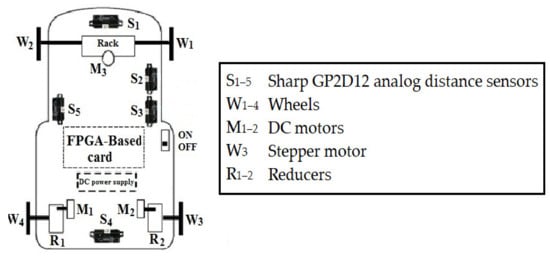
Figure 2.
General view of the mobile robot chassis.
The five infrared sensors (S1-5) collect environmental information to the FPGA-based board, which is responsible for processing the received data to determine the parking mode and controlling the motion and reaction of the stepper and DC motors.
The remainder of this paper is organized as follows. In Section 2, the framework of the proposed AVPS is described and the algorithm, which combines the four modes of automatic parking, is formulated. Simulations based on a case study involving parking resources with description in the Simplorer environment and with the ModelSim simulator are presented in Section 3. The experimental results and implementations are detailed in Section 4. Finally, a conclusion is drawn and some future perspectives are suggested in Section 5.
2. Autonomous and Versatile Mode Parking System (AVPS)
This section deals with the Autonomous and Versatile mode Parking System (AVPS) and its operation. The operational requirements as well as the fast technological development were the main factors underlying the ever-increasing intelligent systems in vehicles, where the sensors play a vital role to perform operations, such as intelligent parking. Intelligent decision makers currently have access to a larger amount of data than ever. All data and information from the various sensors installed on the chassis of the utilized mobile robot in this research provide information for producing real time action. These data are dynamically and electronically processed by the FPGA card allowing not only the recognition of a vacant place but also the parking mode to opt for. The information received from sensors is extracted from data while taking into account the available configuration of one of the parking modes presented in this study.
Figure 3 provides an overview of the virtual Simplorer environment. VHDL-AMS (VHDL language with analog and mixed-signal extensions) is used to specify analog and digital designs and event-driven systems, which allow us to simulate our platform before implementing the AVPS algorithm on the FPGA board.
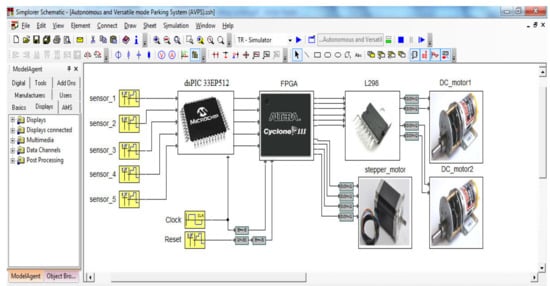
Figure 3.
Robot description in the Simplorer environment.
This figure shows that the VHDL-AMS language is an undiscovered asset for the FPGA designers and also a powerful tool for defining and verifying requirements in a non-digital context. The VHDL-AMS descriptions were developed for each block of the mobile robot, including the functional models. The obtained blocks are connected in the Simplorer software environment to obtain a high-level description of the control of the mobile robot. The displayed blocks include digital electronic models (FPGA) and analogue/digital electronic behavioral descriptions (sensors, A/D converters, microcontroller etc.).
2.1. Determining the Space Constraints
In order to avoid collision during the parking process, the possibility of collision was studied by calculating appropriate distances for each parking mode configuration. Moreover, the constraint conditions were analyzed according to the environment of the vehicle and the parking characteristics. Figure 4 illustrates the constraint conditions according to the selected mode by the proposed AVPS. The values of each distance can be easily calculated, where:

Figure 4.
Presentation of the four combined parking modes.
- D1 represents the required free distance for each parking mode.
- D2 represents the distance between the first and second corner of the same vehicle.
- D3, D4 and D5 represent the minimum distance required for safe parking.
- α represents deviation angle of the parked vehicles.
Figure 5 illustrates the robot parameters, which affect the minimum distance required for safe parking in parallel and perpendicular parking modes.
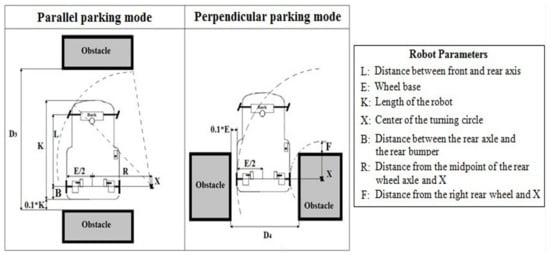
Figure 5.
Parameters affecting the minimum distance required for safe parking.
Distances D3 and D4 in these two modes can be expressed as follows.
For parallel mode:
For perpendicular mode:
We proposed to add a safeguard equal to 10% of the vehicle length (parallel mode) and 10% of wheel base (perpendicular mode), to the parking space to minimize the possibility of a collision due to non-ideal conditions. Distances D2 and D5 in the head-out and head-in angled modes can be expressed as follows.
For head-out angled mode:
For head-in angled mode:
2.2. Proposed Algorithm
The tracking problem is characterized by uncertainty and ambiguities, which are inherent in the underlying scenario and the type of the used sensors in all robotics applications. As outlined in the introduction, we proceeded along the following lines. The real time algorithm, which combines all the parking modes, provides a well-suited methodology that is implemented after that on the FPGA board specifically achieved for the field of robotics research.
The above proposed approach was discussed in a more explicit and concrete way in the rest of this paper. This methodology was designed to generate a real time algorithm, which combines the four parking modes of: parallel, perpendicular, head-in angled and head-out angled as shown in Figure 1.
The idea behind AVPS comes from the current automatic and semi-automatic systems in a single parking mode: parallel, head-in angled, head-out angled or perpendicular. The proposed method combines all those modes assuming that the mobile robot used in this research, just like an autonomous platform, is able to calculate distance D1 corresponding to the free parking place in the range preprocessing data from sensors 2 and 3 as shown in Figure 2. The target parking position is expected to the first free parking lot between two parked vehicles. Figure 6 shows the generic scheme (parking algorithm flowchart) of functional building blocks of the proposed Autonomous and Versatile mode Parking System (AVPS).
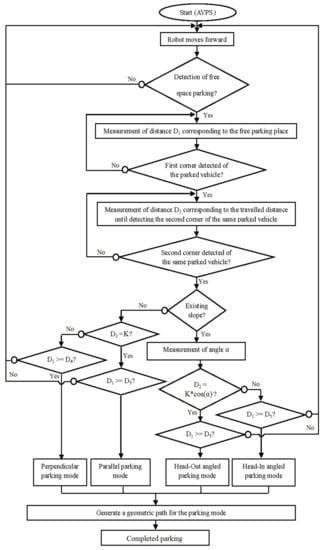
Figure 6.
Flowchart of the AVPS.
The proposed algorithm presented in Figure 6 consists of generating a geometric path for the parking mode that corresponds to:
- (a)
- Detection of free parking space.
- (b)
- Measurement of distance D1 corresponding to the free parking place.
- (c)
- Detection of the first corner of the first detected parked vehicle.
- (d)
- Measurement of distance D2 corresponding to the travelled distance until detecting a second corner of the same parked vehicle indicated in operation c.
- (e)
- Detection of the second corner of the same parked vehicle indicated in operation.
- (f)
- Testing if there is an existing slope? If yes, the proposed AVPS recognizes that the mode is head-in angled mode parking or head-out angled mode. If there is no slope, the same proposed AVPS recognizes intelligently that the configuration of the intelligent parking is a parallel parking mode or perpendicular parking mode. In these two cases, all decisions are made depending on the parking position of the parked vehicles in the parking environment.
- (g)
- If there is a slope, then the real time algorithm calculates the value of the angle α as indicated in the flowchart AVPS proposed system in Figure 6, and the AVPS tests if distance D2 is equal to .
- (h)
- If D2 = , the mode is the head-out angled parking mode, and before executing the parking, the algorithm tests if D1 ≥ D5. If distance D5 allows for the parking operation with a safety margin on the right and on left of the vehicle, the algorithm generates a geometric path for the parking. If D1 < D5, the robot continues to move forward until detecting enough space to park in this configuration. If D2 ≠ , the appropriate mode is the head-in angled parking mode, and the same sequences will be repeated as illustrated above in h and in Figure 6.
- (i)
- If there is no slope, then the real time algorithm tests and calculates the value of distance D2. If D2 = K, there will be another test of the value of the distance D3 if it is less than or equal to D1. If D1 ≥ D3, the appropriate mode is “parallel parking”, and the execution of this mode will also be realized with a safety margin on the right and on the left of the vehicle, and the algorithm generates a geometric path for this mode. If D1 < D3, the robot continues to move forward until detecting enough space to park in this specific configuration. If D2 ≠ K, there will be another test of the value of the distance D4. If D1 ≥ D4, the appropriate mode is “perpendicular parking”, and the execution of this mode respects a safety margin on the right and on the left of the vehicle. The algorithm generates a geometric path for this mode. If D1 < D4, the robot continues to move forward until detecting enough space to park in this configuration.
- (j)
- In the four parking modes indicated in h and i, the proposed AVPS checks if distance D1 satisfies the minimum parking space for generating a geometric path corresponding to the selected parking mode.
- (k)
- Finally, the mobile robot executes the selected parking mode.
3. Simulation Results
3.1. With Description in Simplorer Environment
Herein, we present the simulation results to validate the control performance of the proposed approach, which consists of the development of the AVPS for stable path tracking of the utilized mobile robot in the experimental results. Through computer simulations, the effectiveness and feasibility of the proposed real time algorithm were highlighted. Figure 7 lists the outputs of this system so as to evaluate its performance.
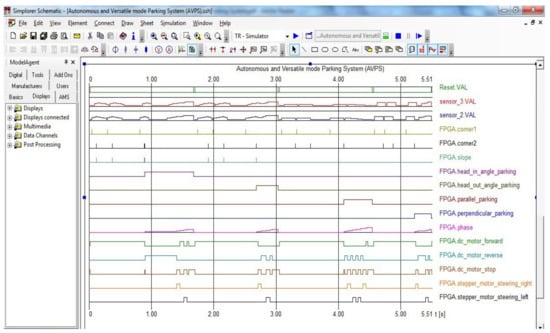
Figure 7.
Simulation results with the Simplorer environment.
They can be detailed as follows:
- Sensor 2 and sensor 3 provide information to determinate the parking mode.
- Corner 1 and corner 2 detection depends on the selected mode.
- The possible existence of a slope is important to calculate the value of the angle α.
- Finally, the reaction of DC motors and the stepper motor.
Obtaining accurate information on the current position of the mobile robot is crucial. The mobile robot has to recognize its position in the environment instantaneously, as well as its direction (forward or backward) and its veering angle φ. There are several position estimations applied in the mobile robot navigation when searching for a free space to park. To assess the reaction of the mobile robot, a remote-control algorithm was developed and implemented on the developed FPGA Cyclone III board. This developed prototype makes it possible to have the characterization and optimization of the behavior of the AVPS where all steps consist of reducing the surface occupation when implementing the real time algorithm.
3.2. With ModelSim Simulator
In this section, we present the test bench structure of the developed AVPS module, simulation result waveforms and generated trajectory in all proposed parking modes as shown in Figure 8, Figure 9 and Figure 10.
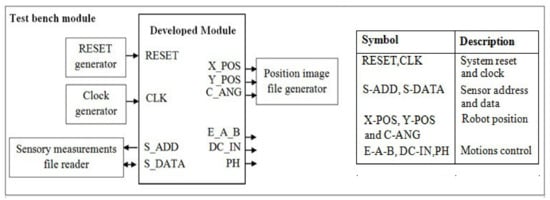
Figure 8.
Test bench structure of the AVPS module.
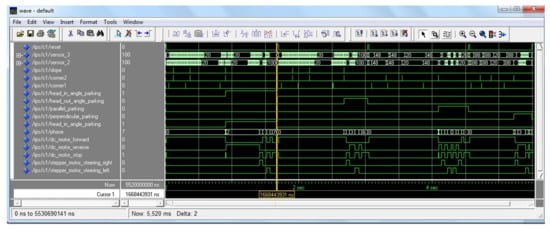
Figure 9.
Simulation results of the proposed methodology.

Figure 10.
Generated trajectory in all proposed parking modes.
4. Experimental Results of the AVPS System
Figure 11 shows the six phases of each parking mode used in our experiments adopting the Autonomous and Versatile mode Parking System (AVPS).
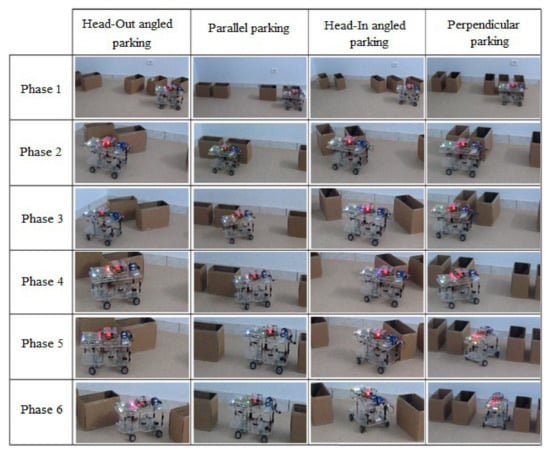
Figure 11.
Experimental illustrations of the four parking modes.
The experimental test was carried out in a customized structured environment. The experimental platform was designed to emulate the real scenarios encountered in real parking environments, including obstacles and existing parked cars. The used robot navigates without guidance, is capable of detecting all obstacles, and determines, with precision, its arrangement between the vehicles already parked, by using the sensors installed on its chassis, according to the existing parking mode.
Five infrared sensors were installed as indicated in the general view of the utilized mobile robot (Figure 2). These sensors were only used for analysis, and allow the information acquisition to locate the position and the orientation of the robot compared to the parking environment. During navigation (forward, backward, forward with deviation and backward with deviation), there is a combined action on the stepper motor responsible for the change of direction and also on the two driven motors on the rear axle to ensure a stable navigation avoiding any obstacle. It can be noticed here that during the orientation change phase in the four presented parking modes, the speed of the robot is much slower than when it is in a rectilinear motion situation, and this enables it to suitably carry out the task of precisely parking without any collision. This task, which seems difficult to apply to many mobile robot models, was validated in our case without any human intervention as on the original platform.
Starting from the experimental results, we assume that the AVPS can be manufactured and implemented in future car generations. A scenario of each parking mode was considered. Collecting data from the five sensors fitted on the mobile robot allowed it to determine the selected parking mode, the position and the orientation. Experiments were focused so that the earlier mentioned AVPS could recognize which parking mode was selected. We tested our system in four situations (parallel parking mode, perpendicular parking mode, head-in angled parking mode and head-out angled parking mode). Each mode consists of six phases, as demonstrated in Figure 11.
5. Conclusions
This paper has analyzed a novel idea for an Autonomous and Versatile Parking System (AVPS) intended to be implemented for future vehicle generation. The adopted method revolves around the recognition of a free parking space between parked vehicles in perpendicular parking mode, parallel parking mode, head-in angled parking mode and head-out angled parking mode using the data provided by infrared sensors. The detection of the two corners of parked vehicles could efficiently allow the selection of the parking mode. Moreover, the free parking space conditions, which have been checked over by calculating distance D1, in the reverse of the detected corners, proved to be reliable and robust. The proposed real time algorithm is able to handle each of the presented parking mode situations. Therefore, the proposed AVPS executed the parking operation without any error. To achieve this objective, the software was developed taking into account the condition the distance threshold D1 and the orientation of the path to track so as to reach the final position of the selected parking mode. The major advantage of the proposed system might be the combination of four parking modes to a single algorithm. This idea could be a good solution to be implemented in the near future of vehicle generation. Furthermore, because of the high price of laser radar, intelligent camera and other intelligent sensors, we have resorted to the infrared sensors in our application. Before proceeding with the experimental tests, a kinematic model of the mobile robot platform was proposed. A real time combinational algorithm was developed using the VHDL language and simulated using the ModelSim simulation tool. These respect our method consisting of a predefined diagram for parking and a tracking control procedure in each of the four presented parking modes. Then, the developed real time algorithm was tested and validated experimentally on a mobile robot system. Other revisions can be proposed in order to improve the system design performances for a variety of industrial applications using mobile robots. The potential future works include creating tests with high performance sensor networks, which may solve exceptional situations, use vehicles as interconnected objects, and conceive a novel system that requires less memory and computation cost than other proposed automatic and semi-automatic parking systems.
Author Contributions
Conceptualization, B.N. and C.A.; methodology, B.N. and C.A.; software, B.N. and C.A.; validation, B.N. and C.A.; formal analysis, B.N. and C.A.; investigation, B.N. and C.A.; resources, B.N., C.A. and M.M.; data curation, B.N. and C.A.; writing—original draft preparation, B.N. and C.A.; writing—review and editing, B.N., C.A. and M.M.; visualization, M.M.; supervision, M.M.; project administration, M.M.; funding acquisition, B.N., C.A. and M.M. All authors have read and agreed to the published version of the manuscript.
Funding
This research received no external funding.
Institutional Review Board Statement
Not applicable.
Informed Consent Statement
Not applicable.
Data Availability Statement
Not applicable.
Conflicts of Interest
The authors declare no conflict of interest.
References
- Park, C.; Pan, J.; Manocha, D. Parallel motion planning using poisson-disk sampling. IEEE Trans. Robot. 2017, 33, 359–371. [Google Scholar] [CrossRef]
- Upadhyay, S.; Ratnoo, A. A Point-to-Ray framework for generating smooth parallel parking maneuvers. IEEE Robot. Autom. Lett. 2018, 3, 1268–1275. [Google Scholar] [CrossRef]
- Li, M.H.; Tseng, P.K. Implementation of an autonomous driving system for parallel and perpendicular parking. In Proceedings of the 2016 IEEE/SICE International Symposium on System Integration, Sapporo, Japan, 13–15 December 2016; pp. 198–203. [Google Scholar]
- Kim, D.J.; Chung, C.C. Automated Perpendicular Parking System with Approximated Clothoid-Based Local Path Planning. IEEE Control Syst. Lett. 2021, 5, 1940–1945. [Google Scholar] [CrossRef]
- Müller, B.; Deutscher, J.; Grodde, S. Continuous Curvature Trajectory Design and Feedforward Control for Parking a Car. IEEE Trans. Control Syst. Technol. 2007, 15, 541–553. [Google Scholar] [CrossRef]
- Kim, D.; Chung, W.; Park, S. Practical motion planning for car-parking control in narrow environment. IET Control Theory Appl. 2010, 4, 129–139. [Google Scholar] [CrossRef]
- Wang, J.M.; Wu, S.T.; Ke, C.W.; Tzeng, B.K. Parking path programming strategy for automatic parking system. Veh. Eng. 2013, 1, 57–63. [Google Scholar]
- Geng, Y.; Cassandras, C.G. New smart parking system based on resource allocation and reservations. IEEE Trans. Intell. Transp. Syst. 2013, 14, 1129–1139. [Google Scholar] [CrossRef]
- Liu, S.; An, X.; Shang, E.; He, H. A path planning method for assistant parallel car-parking. In Proceedings of the 2012 Fifth International Symposium on Computational Intelligence and Design, Hangzhou, China, 28–29 October 2012; pp. 65–68. [Google Scholar]
- Song, J.; Zhang, W.; Wu, X.; Gao, Q. Automatic Perpendicular Parking Trajectory Planning and Following for Vehicle. In Proceedings of the 2019 3rd International Conference on Electronic Information Technology and Computer Engineering (EITCE), Xiamen, China, 18–20 October 2019. [Google Scholar]
- Llorca, D.F.; Álvarez, S.; Sotelo, M.A. Vision-based parking assistance system for leaving perpendicular and angle parking lots. In Proceedings of the 2013 IEEE Intelligent Vehicles Symposium (IV), Gold Coast, QLD, Australia, 23–26 June 2013; pp. 437–442. [Google Scholar]
- Jung, H.G.; Kim, D.S.; Yoon, P.J.; Kim, J. Structure analysis-based parking slot marking recognition for semi-automatic parking system. Lect. Notes Comput. Sci. 2006, 4109, 384–393. [Google Scholar]
- Jung, H.G.; Lee, Y.H.; Kim, J. Uniform user interface for semiautomatic parking slot marking recognition. IEEE Trans. Veh. Technol. 2010, 59, 616–626. [Google Scholar] [CrossRef]
- Hirokawa, M.; Uesugi, N.; Furugori, S.; Kitagawa, T.; Suzuki, K. Effect of haptic assistance on learning vehicle reverse parking skills. IEEE Trans. Haptics 2014, 7, 334–344. [Google Scholar] [CrossRef] [PubMed][Green Version]
- Sándor, Z.; Csiszár, C. Development stages of intelligent parking information systems for trucks. Acta Polytech. Hung. 2013, 10, 161–174. [Google Scholar]
- Ozkul, T.; Moqbel, M.; Al-Dhafri, S. Development of a hierarchical driver aid for parallel parking using fuzzy biomimetic approach. J. Comput. Inf. Technol. 2010, 18, 31–44. [Google Scholar] [CrossRef]
- Kwon, G.R.; Kim, Y.J.; Hong, S.H.; Kim, J.Y.; Pyun, J.Y. Automatic guideline generation for parking assistance system based on on-screen display. In Proceedings of the 2009 IEEE 13th International Symposium on Consumer Electronics, Kyoto, Japan, 25–28 May 2009; pp. 845–846. [Google Scholar]
- Vorobieva, H.; Glaser, S.; Minoiu-Enache, N.; Mammar, S. Automatic parallel parking with geometric continuous-curvature path planning. In Proceedings of the Intelligent Vehicles Symposium, Dearborn, MI, USA, 8–11 June 2014; pp. 465–471. [Google Scholar]
- Vorobieva, H.; Glaser, S.; Minoiu-Enache, N.; Mammar, S. Automatic parallel parking in tiny spots: Path planning and control. IEEE Trans. Intell. Transp. Syst. 2015, 16, 396–410. [Google Scholar] [CrossRef]
- De Oliveira Andrade, K.; Hernandes, A.C.; Becker, M. A rule-based controller simulation for an autonomous parallel parking of a car-like robot using laser sensors. ABCM Sym. Ser. Mechatron. 2012, 5, 1042–1051. [Google Scholar]
- Abdelmoula, C.; Chaari, F.; Masmoudi, M. A new design of a robot prototype autonomous for navigation and parallel parking. J. Autom. Mob. Robot. Intell. Syst. 2009, 3, 47–58. [Google Scholar]
Publisher’s Note: MDPI stays neutral with regard to jurisdictional claims in published maps and institutional affiliations. |
© 2022 by the authors. Licensee MDPI, Basel, Switzerland. This article is an open access article distributed under the terms and conditions of the Creative Commons Attribution (CC BY) license (https://creativecommons.org/licenses/by/4.0/).